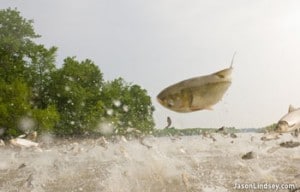Public Hearing in St. Louis Metro Area – Alton, IL
Tuesday, February 8, 2-8pm
Even though we are in the middle of the winter season, the Asian carp are swimming toward the Great Lakes and decision makers are deciding what, if anything, to do. At the same time, scientists continue to study the quagga mussel in Lake Michigan, one of dozens of animals poised to invade the Mississippi River from the Great Lakes. We need you to take time in your hectic schedule to speak out and let decision makers know we want real action and we want it now.

The clock is ticking through March 31st 2011 for a public comment period around the Great Lakes and Mississippi River Basin Interbasin Feasibility Study (GLMRIS). Even though the name of the study isn’t, well, that captivating, it is an important study because its focus will determine if we implement permanent solutions to stop invaders like Asian carp and quagga mussels from spreading between the Great Lakes and Mississippi River basins.
What GLMRIS is: A study authorized by Congress in 2007 mandating that the U.S. Army Corps of Engineers (Corps) determine options available to prevent invasive species from moving through the Chicago waterways in both directions.
Why GLMRIS is important: While there is little debate that fast action to prevent movement of Asian carp is the top priority, there will be no move toward building a permanent solution without successful completion of this federal study.
What is happening now: On February 8th at the National Great Rivers Museum (#2 Locks & Dam Way Alton, IL) from 2 – 8 PM, the Corps will be hosting one of a series of ten public “scoping” meetings to present information and receive comments on the scope of the study.
Our top two reasons why YOU speaking out is so important:
The Corps was mandated to study ways to “prevent” invasive species movement between the Great Lakes and Mississippi River. Deplorably, the Corps has decided to spend precious time and resources to also study ways to “reduce the risk,” not just prevent. This was not authorized by Congress nor is it a credible strategy that will protect our great waters. We need you to tell them this is unacceptable and only options that will “prevent” invasive species movement should be studied.
The Corps study takes too long. The Chicago portion of the study is not predicted to be complete until mid-2015, or nearly five years from now. The Corps must acknowledge the urgency of finding a permanent solution, condense the timeline and produce final results for the Chicago portion of GLMRIS within 18 months rather than mid-2015 and we need you to send that message.
More Talking Points:
- Congress mandated that GLMRIS should only consider “options and technologies available to prevent the spread” of invasive species through the waterways. Physical separation would achieve this. It is not clear at this time that any other alternative would achieve prevention.
- The GLMRIS study is a prevention study and its results should be used first to prevent Asian carp from invading the Great Lakes. The study timeline and strategy must be structured so a solution is delivered prior to the establishment of breeding populations of Asian carp in the Chicago Waterway System.
- The Corps should study and provide a solution for the Chicago Waterway System first regardless of the need to prioritize and act on other aquatic pathways.
- Do not waste time and money repeating work that has already been done or is currently in process.
- Risk Assessment: at least two comprehensive reports describing the likely impacts of Asian carp on the Great Lakes have already been written, one from the U.S. Fish and Wildlife Service and one from Fisheries and Oceans Canada: (www.fws.gov/contaminants/OtherDocuments/ACBSRAFinalReport2005.pdf, www.dfompo.gc.ca/csas/Csas/DocREC/2004/RES2004_103_E.pdf). In addition, Fisheries and Oceans Canada recently commenced a bi-national effort to create an updated risk assessment for Asian carp. There is copious literature describing the potential movement of other invasive species via the Chicago Waterway System and the impacts of the movement of zebra mussels into the Mississippi River basin via the CWS are well-documented. There is absolutely no justification for the Corps to place higher priority on conducting its own risk assessment than on preventing the spread of Asian Carp through the CWS.
- Wastewater and Transportation: The Great Lakes Commission and Great Lakes-St. Lawrence Cities Initiative (GLC/GLSLCI) are conducting a study on the water management and transportation alternatives available after a physical separation of the Great Lakes and Mississippi River. Other organizations, such as the Alliance for the Great Lakes and the Natural Resources Defense Council, have also described alternatives for achieving prevention through a physical separation. The Corps should incorporate the findings of these projects to hasten its own analysis.
- Economic analysis: Likewise, the GLC/GLSLCI includes an economic impact analysis, will be conducted by an elite-tier private engineering and transportation team and should be completed by January 2012. The Corps should use this economic analysis for identifying the best way to achieve physical separation on the Chicago Waterway System rather than writing its own.
- The Corps should create an opportunity for regular – preferably at least twice annually – discussion forums during which the public can interact with technical staff for detailed Q&A on project progress. This should be separate and in addition to the requirements of the NEPA process.
How you can speak out:
If you can, attend a public meeting and register to speak before the meeting so you will be given preference.
See the full list of meetings and how to register here: http://glmris.anl.gov/involve/pubschedule/index.cfm
If you can’t attend a meeting, submit written comments on-line here:
http://glmris.anl.gov/involve/comments/index.cfm
You can download the Corps’ Project Management Plan (PMP) for GLMRIS, the Federal Register notice of the preparation of an Environmental Impact Statement and other documents here:







